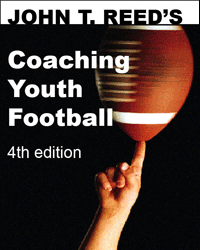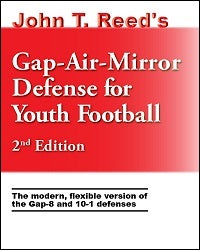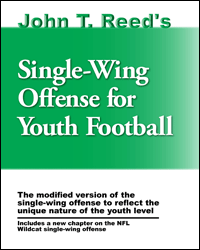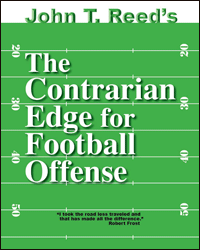Should your youth-football team use the same offense and defense as your local high school?
Posted by John Reed on
Copyright 2000 John T. Reed
Hell, no!
- 73% of youth athletes are out of all youth sports by age 13. The other 27% tend to specialize in one sport for high school, and they don't all choose football. The typical youth team only has about six kids (20%) who are going to wind up ever playing high-school varsity football. See my Where are they now article. So to run your local high-school's schemes on the theory that your players are all going to play high school football in the future is the six-man tail wagging the 29-man remainder-of-the-team dog. Run the team for all the kids that are on it, not just the handful who will play high-school varsity football.

- Players move. The national average is about 15% per year. So you can calculate the probability that any given player on your youth team will play for your local high-school varisty by raising 100% - 15% = 85% to the power of the number of years between now and his junior year of high school. For example, the probability that a given ten-year old will still live in the area when he is 16 would be .85 x .85 x .85 x .85 x .85 x .85 = .38 or 38%. When you combine the probability that a given ten-year old will still be playing football anywhere when he is 16 with the probability that he will still live in your area you get 20% x 38% = 7.6% chance that he will both play football and still live in your area.
- Players who do not move often attend another high school. The fact that a player does not move away does not necessarily mean he will attend your local public high school. Youth-football players I coached who did not move ended up playing for about four different local public high schools (Monte Vista, San Ramon Valley, California, Miramonte) and one local Catholic high school (De La Salle). So if you live in an area where your youth teams feeds more than one high school, the question becomes which high school's system do you adopt? In my area, although about five players from each youth team ended up playing high-school varsity football, only about one (20%) went to each of the different local high schools. So only one player and high school would get any benefit from having become familiar with a local high school's system. Furthermore, the high school in question would probably suffer from the other former youth players taking their knowledge to an opposing high school. Combining this fact with the above two, the chances of a given ten-year old attending your local high school and playing football are 20% x 38% x 20% = 1.52%.
-
 Coaches move up. Not only do high-school coaches get fired for doing badly, they often get a chance to move up to a better high school or to college or pro football if they do well. It would be logical to only use your local high school's system if it was working at that high school. But the more it works at that high school, the greater the probability that coach will move on to bigger and better things. Coaches get fired. When I started at California High School as a youth coach in 1990, the California High coach asked that we used his system. He was doing lousy. Two years later, Dwayne Murphy, the former Oakland Athletic, took over. He put in a new system, but also did lousy and left after a few years to coach the Diamondbacks. Then Brad Tubbs arrived. He also put in a new system and has had a good year after a couple of bad ones. Then he got fired, as did his successor. If the San Ramon Bears had used California High School’s system, the poor kids would now be on their third or fourth system. And most of the kids in question would end up playing for Monte Vista or San RamonCal High opponents or De La Salle.
Coaches move up. Not only do high-school coaches get fired for doing badly, they often get a chance to move up to a better high school or to college or pro football if they do well. It would be logical to only use your local high school's system if it was working at that high school. But the more it works at that high school, the greater the probability that coach will move on to bigger and better things. Coaches get fired. When I started at California High School as a youth coach in 1990, the California High coach asked that we used his system. He was doing lousy. Two years later, Dwayne Murphy, the former Oakland Athletic, took over. He put in a new system, but also did lousy and left after a few years to coach the Diamondbacks. Then Brad Tubbs arrived. He also put in a new system and has had a good year after a couple of bad ones. Then he got fired, as did his successor. If the San Ramon Bears had used California High School’s system, the poor kids would now be on their third or fourth system. And most of the kids in question would end up playing for Monte Vista or San RamonCal High opponents or De La Salle. -
 Coaches hire new assistants. Maybe your head coach both stays in his job and stays with his offensive system, but he hires a new defensive coordinator who totally changes the school's approach to defense. Sorry about that, too.
Coaches hire new assistants. Maybe your head coach both stays in his job and stays with his offensive system, but he hires a new defensive coordinator who totally changes the school's approach to defense. Sorry about that, too.
- Coaches change their minds. Maybe your local high-school coach neither gets fired nor moves up in the next five or six years. But that does not guarantee that he will not change his mind about what offense or defense he wants to use. If some other scheme becomes fashionable, or his is impressed by a clinic speaker, or he gets his butt kicked by a school using a different system, he may change. Hey, we put in your system at your request three years ago. What do you mean you're changing it? Oh, yeah. Sorry about that.
- It ain't the same! Most high-school coaches have never coached youth football. They assume they know everything there is to know about youth football on the grounds that they coach at a higher level. In fact, youth football is quite different because of the obvious reasons: less size, speed, strength, emotional maturity, athletic maturity, brain maturity, practice time, but also for reasons that are not obvious: minimum-play rules, majority of players non-athletes, incompetent coaches. Much of what works at the high-school level does not work in youth football and vice versa. For example, the most successful youth play is generally the sweep. But in high school, it's the off-tackle.
-
 System, shmystem. What difference does it make if local youth coaches run the same system? The main thing is to get the youth players over their fear of hitting and teach them fundmentals like rules, blocking, and tackling. Freshman football players can learn things like the high school's hole-and-back-numbering system in a day or two. I know because I coached freshman football. What took us time at the freshman level was getting rookies over their fear of hitting and teaching them to stay still until the snap and all that. We wished the local youth program had done that. They did, but only for about five of our fifty players. No way would we trust the local youth team to put in our system. We put it in from scratch as if the local Pop Warner players knew nothing. If a 16-year-old stud tansfers into your local high school from the other side of the country, and he never played in any youth or high school system remotely resembling your high school’s, is the varsity coach going to tell the kid to go play soccer? Hell, no! He’ll teach the kid his system in a few days or a week and the kid will start over your youth players who have been running the system for eight years.
System, shmystem. What difference does it make if local youth coaches run the same system? The main thing is to get the youth players over their fear of hitting and teach them fundmentals like rules, blocking, and tackling. Freshman football players can learn things like the high school's hole-and-back-numbering system in a day or two. I know because I coached freshman football. What took us time at the freshman level was getting rookies over their fear of hitting and teaching them to stay still until the snap and all that. We wished the local youth program had done that. They did, but only for about five of our fifty players. No way would we trust the local youth team to put in our system. We put it in from scratch as if the local Pop Warner players knew nothing. If a 16-year-old stud tansfers into your local high school from the other side of the country, and he never played in any youth or high school system remotely resembling your high school’s, is the varsity coach going to tell the kid to go play soccer? Hell, no! He’ll teach the kid his system in a few days or a week and the kid will start over your youth players who have been running the system for eight years.
- Most high school coaches are wimps. If your local high school coach is a football genius and using the best system he can come up with, I would be inclined to use his system, too, if I were a youth coach there. But the majority of high-school football coaches are conformists. They use the same offense and defense as everyone else, or at least an accepted, popular offense and defense, because if they don't, and the one they use does not work, they will be highly criticized and probably fired. By using the same schemes as everyone else, even though they do not totally believe in them, they can blame the players when they lose. (e.g., The better team won.)
-
 The notion that a youth program using a local high school’s system makes the high school team better is total bullshit. A high school coach demanding that is just a manifestation of how profoundly selfish and paranoid and scared high school coaches can be. They would destroy the youth careerrs of all the players and coaches in their community if they thought there was a 1% chance it might help THEIR high school career. The same is true of high school off-season conditioning programs. I coached at a school that had a big one and a school that had almost none. The school with almost none, and had a 1/3 smaller student body, beat the school with the heavy conditioning program. Why? The heavy conditioning school drove away many of its best athletes from the sport.The best high-school football team in the history of the universe is probably our local De La Salle High School. They set a 151-game win streak which broke the old world record of 72. They have no youth football feeder program. That Catholic school gets their players from a half dozen different youth flag and tackle programs. Their defensive coordinator once told me that many of their best players played soccer until high school. So how important can a youth feeder program be?
The notion that a youth program using a local high school’s system makes the high school team better is total bullshit. A high school coach demanding that is just a manifestation of how profoundly selfish and paranoid and scared high school coaches can be. They would destroy the youth careerrs of all the players and coaches in their community if they thought there was a 1% chance it might help THEIR high school career. The same is true of high school off-season conditioning programs. I coached at a school that had a big one and a school that had almost none. The school with almost none, and had a 1/3 smaller student body, beat the school with the heavy conditioning program. Why? The heavy conditioning school drove away many of its best athletes from the sport.The best high-school football team in the history of the universe is probably our local De La Salle High School. They set a 151-game win streak which broke the old world record of 72. They have no youth football feeder program. That Catholic school gets their players from a half dozen different youth flag and tackle programs. Their defensive coordinator once told me that many of their best players played soccer until high school. So how important can a youth feeder program be?

Memo to high-school head coaches:
Let me address the high-school coaches here. Some readers of this page will probably print it out and take it to the youth board and/or the high-school coach.
If you want the youth coaches to implement your system, sell them on it. Integrate them into some of your meetings and practices. Their brains are almost blank slates when it comes to knowing how to coach football. If you make the effort, they will probably do it your way because now your way is the only one they know. That is especially true if you are successful.
Do NOT cram your system down your local youth program's throat by threatening to take away their field or crap like that. How would you like it if your local community college head football coach demanded that you run his system? You actually could make a better argument for that than for a youth program using a high-school system.
All football coaches, youth or higher level, should use the system they believe in. If you take that away, you are turning them into day-care workers or equipment managers. I would refuse to coach at such a youth program. So would most good youth coaches. Youth coaching is already abysmal. Driving out the few good coaches is insane.
Don't tell us how to do it. Show us. If you are so darned smart about how to coach a youth-football team, have some of your high-school coaches take one of the youth teams preferably the oldest who are a year away from high school. Then, when those coaches kick butt with your wonderful system, the lower level youth coaches will probably gravitate toward it.
About the only system stuff a high-school coach could legitimately want a youth program to help him with is stuff that requires thousands of reps, like running the triple option or a few selected pass plays. Plays that can be put in with a few hundred reps or fewer do not need more than three years to learn well. Forcrissakes, coach, you've got the kids for their freshman and sophomore years. If you can't teach them your system in that much time, you need a simpler system, especially when you consider that only about 10% of the typical freshman football team has played youth football and some of them just moved into your town so they know another system.
Only ask the oldest youth level to use your system. Leave the 12-and-under coaches alone. Their players are really playing a different sport to a large extent and, for the various reasons stated above, you probably will not be their coach and/or using the same system when they get to their junior year of high school anyway.
If your high-school team is not successful, do not tell the local youth program to use your system. They will likely laugh in your face. When a local 0-8-2 high-school coach told us to use his system, I suggested that he use ours. We were 9-2. He did not appreciate such impertinence. He also didn't use our system and had another lousy season, after which he was fired.
The vast majority of youth coaches want desperately to be noticed and helped by the local high-school coaches. But they do not want to be dictated to, especially by some unsuccessful guy who has not thought through the need for the local youth team to use his system and who has not done his homework on the nature of youth football. Approach the youth coaches correctly and you can help each other.
Good luck,
John T. Reed
Share this post
0 comment




